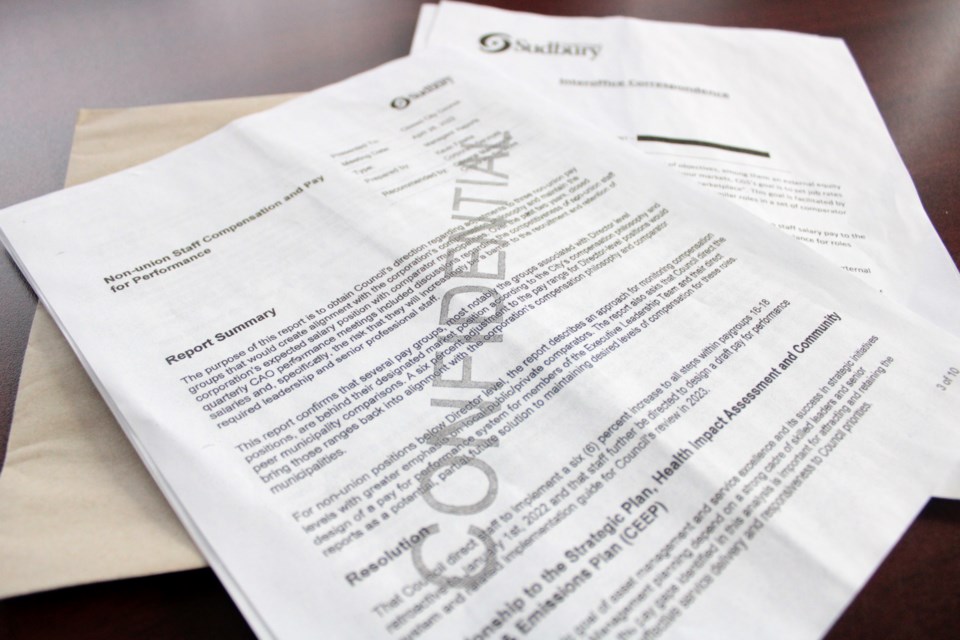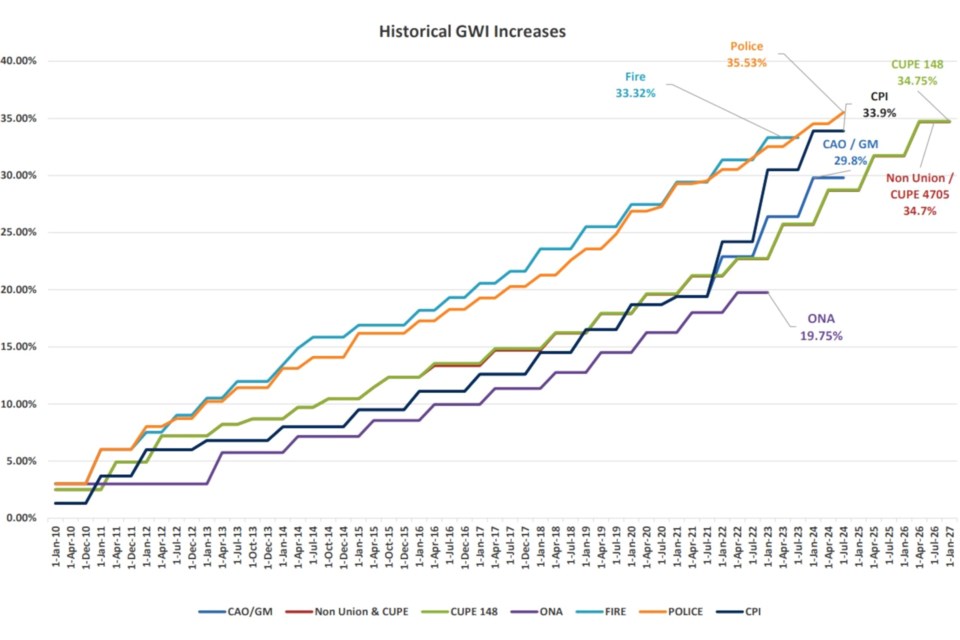Pay hikes approved for some of the City of Greater Sudbury’s highest paid non-union managers begs the question: How did other city employees’ wages fare in recent years?
After all, some lower pay groups have been lagging even further behind municipal comparators and did not receive comparable salary boosts to those given to senior managers.
There’s also the question of transparency, and whether other salary adjustments have taken place without the public knowing about it.
Last year’s pay increases of six- to nine-per-cent for pay groups 15-18 (city directors and other senior managers) came without public notice. Sudbury.com only learned about these pay hikes, which carry an annual cost of $520,000, because we received leaked documents from an anonymous source.

What other pay increases have taken place without the public’s knowledge?
Sudbury.com reached out to city communications staff and city CAO Ed Archer to provide this additional context.
Transparency is an ongoing target, Archer said, noting staff will continue to follow city council direction.
General wage increase percentages have been fairly even across the board since at least 2010.
However, salary increases are complicated by the fact various additional boosts beyond general wage increases take place each year, including last year’s salary spike for pay groups 15-18.
The pay boost discrepancy question
The city’s rationale for providing an eight-per-cent additional salary boost for non-union pay groups 16-18 (directors), and a six-per-cent boost to pay group 15 (senior managers) last year was that their wages had fallen behind the average for those roles.
As city CAO Ed Archer explained to Sudbury.com, the city’s goal is to hit the 50th percentile among comparator municipalities (the middle) when it comes to salaries in order to remain competitive.
The city has fallen behind in recent years, which Archer said necessitated the boosts he approved last year using the delegated authority afforded to him by city council.
A 2022 closed-session municipal report leaked to Sudbury.com outlined this discrepancy as of 2021, which noted that pay group 15 lagged seven-per-cent behind comparator municipalities’ average salary. Pay groups 16 and 17 lagged by more than 10 per cent.
Meanwhile, the pay discrepancy between City of Greater Sudbury and comparator municipalities was even greater for lower pay groups.
Pay group five (program supervisors and speciality program instructors) lagged by 35.2 per cent, while pay groups six (administrative assistants/receptionists and administrative clerks) and seven (administrative assistance) lagged by more than 20 per cent.
So, why adjust pay groups 15-18 last year, and not the lower pay groups whose discrepancy is much greater?
“There’s a broader candidate pool for the groups five to nine jobs, and they tend to be local,” Archer told Sudbury.com. “If we do have discrepancies that create attraction issues or retention problems for those jobs, then we go through a similar exercise.”
The positions in pay groups 15-18 “are the ones that require significant experience, significant technical knowledge and/or both,” he added. “They tend to be jobs that we look both within the community and outside the community to attract candidates for.”
These more senior roles tend to be filled by people in the later stages of their careers, he said, adding that the fact many of them are reaching retirement age “has exacerbated the need for recruiting.”
What other wage increases have taken place?
The city provided Sudbury.com with a chart highlighting general wage increases since January 1, 2010, which shows them accelerate at roughly the same rate across the board.
The following are the cumulative percentage increases (2010 to present) each wage group provided received:
- Firefighters’ salaries had increased by 33.32 per cent by July 2023
- Police salaries had increased by 35.53 per cent by July 2024
- The CAO and four general managers’ salaries increased by 29.8 per cent by July 2024
- CUPE 148 salaries are slated to jump by 34.75 per cent by January 2027
- Non-union staff and CUPE Local 4705 members will jump by 34.7 per cent by January 2027
- Ontario Nurses Association members’ pay increased by 19.75 per cent by January 2023
Meanwhile, since Jan. 1, 2010, the city noted the consumer price index will have increased by 33.9 per cent by July 2024.
Pay increases in addition to these general wage increases have been:
- Last year’s six-per cent boost for pay group 15 and eight-per-cent increase for pay groups 16-18
- In 2017, one position in pay groups 12-13 (assistant managers, officers, co-ordinators, managers) received a pay boost of 10 per cent
- In 2019, one position in pay groups 13-14 (managers, professional individual contributor) received a pay boost of 10 per cent
In addition to this, each year finds an average of 19 unionized positions reviewed by the city to ensure they’re in line with the market. These reviews are subject to collective bargaining and are approved and ratified by city council.
Last year, 33 unionized positions (169 people including part-time staff) were evaluated “to better align with market expectations, which came at a total annual cost of $651,000.
What about City of Greater Sudbury transparency?
There was nothing legally prohibiting the City of Greater Sudbury from publicly divulging last year’s pay group increases.
Further, some members of city council, including Ward 7 Coun. Natalie Labbée, said they were not made aware of the wage increases until after the fact.
The bylaw city council approved last year to give the city CAO delegated authority to adjust non-union wages in accordance with the city’s salary administration plan did not require Archer to return to city council with his decision.
In the wake of the wage increases coming to light in Sudbury.com’s coverage, city council passed a motion last month for the city to review its salary policy, with a report to be tabled by the end of September.
As part of this review, Archer said he expects transparency will come up.
“We will always follow council’s direction,” he said, adding that staff will adapt to evolving expectations and better practices.
Sudbury.com reached out to CUPE Local 4705 for their response, which will be included in a follow-up story to be published soon.
Tyler Clarke covers city hall and political affairs for Sudbury.com.
